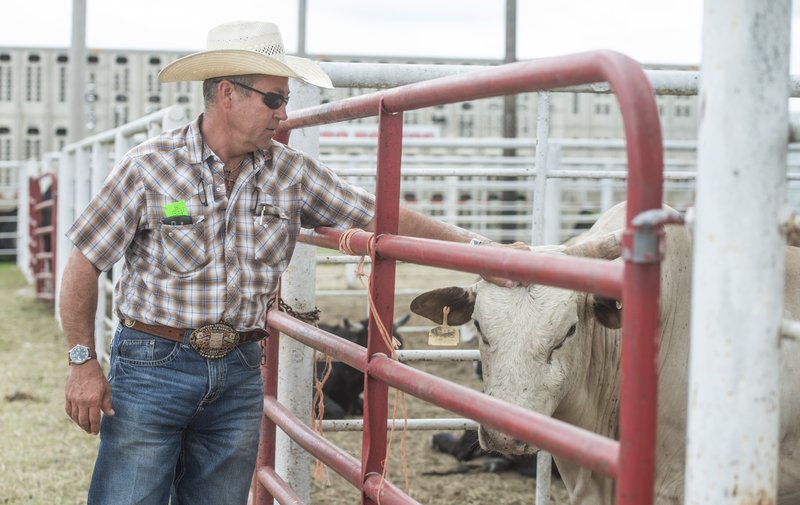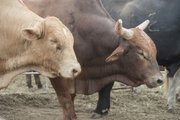The bulls are some of the biggest and baddest in professional rodeo. Brought to Springdale by Stace Smith Pro Rodeos, the bulls held the lead at the 71st annual Rodeo of the Ozarks -- only two cowboys made qualified eight-second rides as of the second night of rodeo action at Parsons Stadium. The rest of the cowboys met the arena dirt face to face. The final performance of the rodeo starts at 7:30 p.m. today.
Terry Autrey, stock superintendent for Smith rodeos, standing calmly next to a pen of the rodeo's wild stock, shared facts about the beautiful behemoths.
• Bulls are all male.
• Ninety percent of all bulls have black eyes.
• Smith Pro Rodeos runs an active breeding operation. The foundation of the stock today descended from 145 Wildberry, a National Rodeo Finals bull purchased in 2006 in Quapaw, Okla., for $35,000 -- a meager amount compared to some of today's sales.
"If a cow (bred to Wildberry's descendants) gives birth to a bull calf who bucks, and the next year has another bull calf that bucks, keep her. That's a good cow," Autrey said.
• Smith also buys bulls from other stock producers at all levels of rodeo and even at a local sale barn, if they show potential.
Magic Bullet, who threw off Nic Lica of Garden City, Mich., Thursday night, more recently was purchased from Kishs Buckin Best breeding program in California for $50,000.
• To determine if a calf shows potential as bucking stock, Smith's staff straps a "dummy" box on the bull calf. If the bull doesn't like the box, and turns and kicks trying to remove it, he might grow into a great bucking bull.
• Some bulls are right-handed; others are left. Individual bulls buck and turn to the right side or the left side when the gate opens, Autrey explained. The bucking chutes at Parsons Stadium reflect this, with bulls loaded so they are able to turn out to their preferred sides.
• Bulls are not trained to buck, and each has its own style of bucking.
• Working on alternate nights, bucking for eight seconds, an average Smith bull might "work" for only two minutes a year. But loading in the livestock trailers and travel to about 50 rodeos a year takes its toll, Autrey said.
Healthy bucking bulls reach their primes at about 4 to 6 years of age -- although some can still buck at 8 or 10 years. Smith begins to buck his bulls at local rodeos at about 3 years of age, Autrey said. "And at 5, we put them on the truck and go."
He likened a bull's career to that of a professional football player who performs using his entire body.
• The average weight of a rodeo bucking bull is about 2,000 pounds, although individual bulls might range from 1,500 to 2,200 pounds. But bigger isn't always better -- smaller bulls means more room in the livestock trailer.
"They're like humans,"Autrey said. "Some are bigger, some are taller, some are healthier."
• Each of Smith's bulls are fed 12 to 15 pounds of feed a day -- which is purchased locally, Autrey said. And the bulls are used to drinking "city water," he said.
Bulls get grain in the morning and hay their rides at night. Pro football players don't eat a plate of food before games; nor do swimmers, Autrey said. Just like people, bulls can get sluggish when their bellies are full.
For all the stock that made the trip to Springdale, Smith buys feed 2 to 5 tons at a time.
• Many bulls know when it's time to perform. Some know when the stock handlers start moving them to pens and putting on flank straps about 4 p.m. before the rodeo. Others figure it out when they are loaded in chutes.
"But they know when they get in those bucking chutes that it's game time," Autrey continued. "And that red bull over there (Miami Heat) thinks it's game time all the time, he added.
• In addition to the urge to buck, Smith's handlers pull a flank strap really tightly around a bull's waist. "It's like a really tight belt they are trying to kick off," Autrey said -- another trait bulls share with humans.
The cowboys tie their own bull ropes around the animals' shoulders, giving them a hand hold for the one with which they are allowed to ride.
• Not all of the bulls in Springdale this week belonged to Smith. While Smith Pro Rodeos owns enough bulls to put this rodeo on, Autrey said, the company doesn't own enough of the best bulls for each bull rider to be given a fair chance to win -- the animal is judged alongside the cowboy for a top score of 50 points. That score is added to the cowboy's score -- again, a top of 50 points.
The Rodeo of the Ozarks board signs a contract with Smith, who in turn, brokers contracts with other stock producers to bring bulls to this rodeo.
• The bulls do seem to defy gravity. "There's a sweet spot in the center of the bulls shoulders, where you don't feel the effects of centrifugal force," said Autrey, a former bull rider. "It's different on each bull, and you have to find it."
• Each bull has its own personality, which the handlers learn. Autrey reported Border Patrol -- who is yet to be ridden for the full eight seconds -- to be the "meanest" bull he has seen in a while. His back is as tall as a man's head, he has long horns, and he looks down at people, Autrey described. Most handlers are afraid of him; Autrey said he respects the bull.
However, back in Malakoff, another bull will nearly knock down a fence coming to get his back scratched and get some affection, Autrey said.
• "They're all my pets," Autrey concluded.
NW News on 07/04/2015

